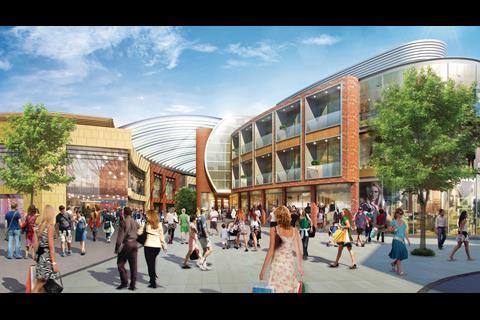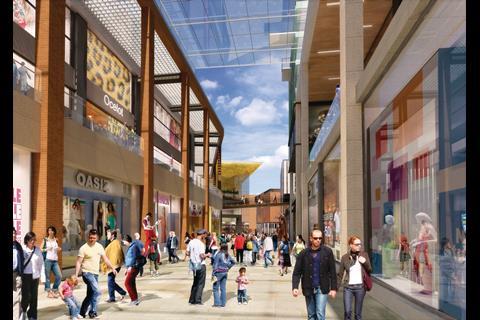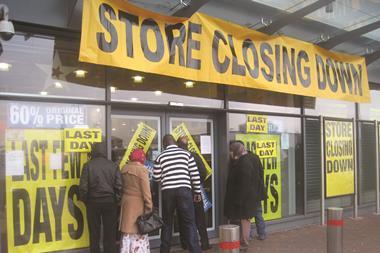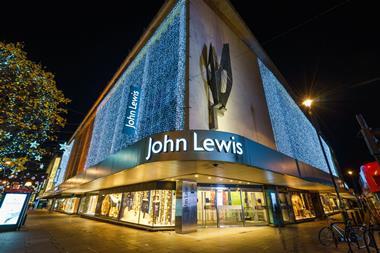The freeze in the development pipeline has switched the focus from the UK’s biggest retail centres to those that are under-served. Mark Faithfull considers some of the opportunities around the country.
Last there was Westfield Stratford City, next there is Trinity Leeds. And that is pretty much the book of UK retail development – or lack of it – should one only consider the big beasts of British malls. In their wake lie the ruins of so many retail-led town centre redevelopments, many of them in truth laughably over-grandiose and well and truly spiked by the recession.
Yet amid this economy-enforced development moratorium, UK local authorities are looking to work with developers to reignite stalled schemes and to help in-town retail development after the near collapse of the development market. Their manoeuvres come as long-term proposed developments remain dormant, while so-called right-sizing (making smaller, in other words) and the ongoing downturn put the brakes on much-needed contemporary space.
Not surprisingly, much of the renewed focus is on the locations where schemes had been proposed but which were stymied by the recession, and the UK’s affluent market towns, which have survived the downturn in relatively good shape.
One example has been the stop-start plan for the affluent Northwest town of Chester, which originally was to have a significant retail development created as a contemporary adjunct to its historical centre. ING Real Estate had long-held plans to deliver a circa 400,000 sq ft retail-led regeneration project in the city, which had been due to start in 2007 but was derailed by the downturn. In September 2010, the council agreed to a three-year extension to the plans but declined to grant the five-year extension ING initially proposed.
However, in February, Cheshire West and Chester Council finally revealed a new concept for the city’s Northgate shopping development and the council said it would work up plans for a scheme which, while remaining retail-led, would contain an increased proportion of leisure space, including a multiplex cinema, restaurants, a central market and new library, a number of larger shop units, plus space for a department store.
The council said over the next few months a cross-party working group would prepare a detailed feasibility plan, together with a detailed scheme and business case to be reported to the executive in the summer.
ING has hit back at the council’s decision, arguing it would add years of further delay to the project. ING, which owns land within the Northgate site, added that it would be “willing and able” to regenerate the area and would work up its own plans for its landholdings.
Meanwhile, UK Commercial Property Trust (UKCPT) has submitted a planning application to Shropshire Council for the redevelopment of Shrewsbury’s Pride Hill, Darwin and Riverside shopping centres into a single 450,000 sq ft centre called New Riverside. The £150m regeneration project will include the demolition of the existing Riverside centre and the construction of a new 210,000 sq ft centre that will be integrated with the Darwin and Pride Hall centres and provide stronger links to the town centre. The proposals include a department store, 50 new shops, 10 restaurants, offices and car parking.
Shrewsbury is one of a relatively small number of sites across the UK that has not experienced significant retail development for a long period and − subject to planning consent and the signing of pre-lets with tenants − the redevelopment is scheduled for completion in 2016.
UKCPT says it believes that Shrewsbury has significant potential as a retail destination, as a sub-regional county town with a large, affluent catchment area, where no new retail space has been built in the past 20 years. UKCPT chairman Christopher Hill describes New Riverside project as “transformational” for the town. Together with its development manager, Shearer Property Group, he says it will create an “exciting, deliverable scheme”.
Queensberry Real Estate has submitted a detailed planning application for the Friars Walk retail development in Newport. The company says pre-let discussions with retailers have progressed well, adding that a major department store letting is imminent and that further deals with big space users and a cinema operator are anticipated.
It is expected that consent will be granted in April, allowing Queensberry Real Estate to negotiate funding terms with several interested parties. Developer Modus was due to oversee the £230m Friars Walk scheme before it collapsed into administration in June 2009. Newport served formal notice on the development in August 2010 and confirmed it would acquire the properties via a compulsory purchase order.
Queensberry Real Estate was chosen as the preferred developer for the 390,000 sq ft retail regeneration scheme in May. Paul Sargent, partner at the company, says: “Speed of reaction to the market’s ever-changing needs is essential these days and we feel it is more astute to go straight to a detailed application after close consultation with major retailers, so that the timeline between contract negotiation and store opening can be kept to a minimum.”

Meanwhile, this autumn signals completion of the first stage of the £350m City Sentral development in Stoke, when a new bus station opens as part of Realis Estates’ work to improve public transport links to the project, which sits adjacent to the main city centre shops. Realis has already agreed heads of terms with two anchor tenants – Marks & Spencer has signed up for a 107,650 sq ft store within the 645,856 sq ft, 70-store revamp of the East West shopping precinct and cinema operator Vue has signed heads of terms to open a six-screen cinema. The project is scheduled for completion in 2015.
Ahead of all these, the £100m Brewery Square in Dorchester, due to open in October, will include 40 stores, restaurants and a cinema.
A joint venture between Waterhouse and Resolution Property, it extends over 11.5 acres on the former Eldridge Pope Brewery site, and work is well underway on phase two to create 68 apartments, 16 more shops and six restaurants, two hotels, an Odeon cinema, a 45-bed care home and 42 close-care apartments, with completion due for October. Pre-lets include Zizzi, Carluccio’s, Wagamama, Hobbs, Café Rouge and Pizza Express as well as a pharmacy and local shops.
Waterhouse founder Andrew Wadsworth says the scheme has been designed to provide a mixture of lifestyle and needs-based food and retail offers for residents, workers, visitors and tourists. “We have created Brewery Square as a complete lifestyle-type offer,” he says. “So the retail has to fit comfortably with the environment, add to the quality of the various elements and ideally bring something new to Dorchester.”
He adds: “It would be easy to fill a scheme like this with whatever retailers liked the look of, but that would detract from the ethos of what we have done here,” Wadsworth insists. “I certainly believe the concept is replicable and gets back to the reasons why people love town centres.”
A shaky backdrop
However, the plans for Chester, Shrewsbury and Newport come less than three months after hopes for a large scale redevelopment in Preston, aimed at establishing it as the Northwest’s third retail city, ground to a halt, reminding everyone of the frailty of the market.
The withdrawal by department store group John Lewis derailed an ambitious £700m shopping centre-led regeneration scheme for the city and left any future development in doubt. John Lewis agreed to anchor Lend Lease’s Tithebarn project four years ago as the core element of the 1.5 million sq ft shopping, leisure and housing project, which would have resulted in 32 acres of Preston city centre reshaped and rebuilt.
While the local authority still hopes to push a retail-led scheme forward, Preston council leader Peter Rankin said of the decision: “While our aim is still to regenerate the Tithebarn area, we have to be realistic. In today’s market conditions, it was certainly not right.”
The retailer’s decision – based on a view that it could not make the planned Preston store viable – will inevitably concern other shopping centre developers. In 2005, John Lewis announced ambitious plans to open a new department store each year until 2015, and it is waiting in the wings to anchor large, delayed schemes in cities such as Centros’ Northern Quarter in Portsmouth, Hammerson’s Eastgate Quarters in Leeds and Sevenstone in Sheffield.
However, not all the opportunities are in new retail developments, says Guy Grainger, head of UK retail at Jones Lang LaSalle. “It’s clear that opportunities are biased towards the cathedral locations around Britain, which have largely held up very well during the downturn. Regionally, the positive effect of London and the Southeast seems to have spread to about one and a half hours’ commute from the capital.”
An obvious example is Surrey commuter-belt town Guildford. With a strong high street and its Friary shopping centre at the foot of the main retail run, Guildford’s retail has been performing strongly and the mall changed hands from Westfield to Hermes recently, with the latter set to submit plans to double the size of Friary.
Grainger also cites under-the-radar towns such as Bedford and Welwyn Garden City as examples of locations with stable employment and further room for retail expansion, while he also believes that regeneration for the Olympics will benefit east London’s retail scene generally. “In contrast with the affluent market towns, you have locations around east London which are coming off a low base and have room to improve significantly,” he says.
At the heart of any such revitalisation is financing, or the lack of it. Those projects relying on nervous banks to deliver will find it so much harder to deliver as the banks resist overtures to loosen the purse strings. That lag is an opportunity for some but suggests frustrating times for retailers scouring for new space as far ahead as 2015.
Mixing residential and retail in Nottingham
In March, UK Regeneration (UKR) launched its model for private sector-led regeneration in the residential market with the first pilot village to be built in Nottingham and including retail among its proposed 200 homes. UKR chief executive Jackie Sadek has led the UKR- developed model to develop infill city centre sites, providing mixed-use villages designed to meet local community needs. The schemes will not only deliver social housing but also aim to attract retail and food and beverage outlets to provide street level services.
Each development will need to be commercial in its own right in order to sustain the model nationwide, after UKR pledged last summer that it would deliver 20,000 homes by 2020.
The homes at Sandfield Village will be designed to establish renting as an aspiration and positive choice. A mix of convenience shopping, niche boutiques and local operators will be blended with the homes, and Sadek is keen that the retail businesses attracted should reflect the aspirational ethos of the project.
Sadek says: “This has been the journey of my life and it will be the first residential project that has truly been designed around the consumer. It’s radical, it is a game-changer and it will be entirely predicated on people.”
UKR has brought together a team covering all aspects of the scheme, including agent Jones Lang LaSalle, Barclays, Wates, Eversheds, EC Harris, Redbox Design Group and Workspace Group.































No comments yet